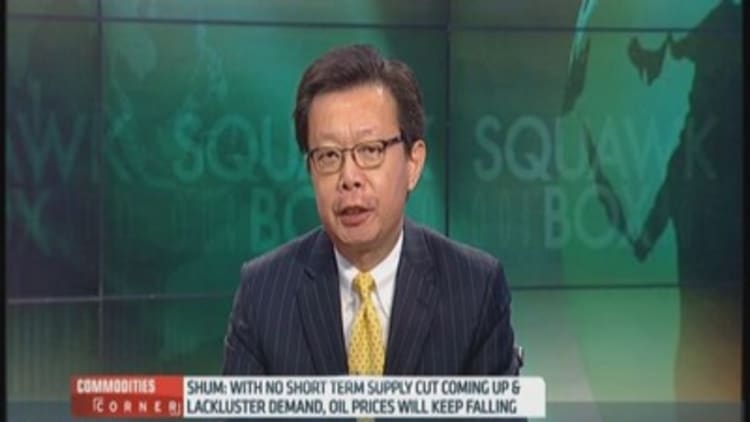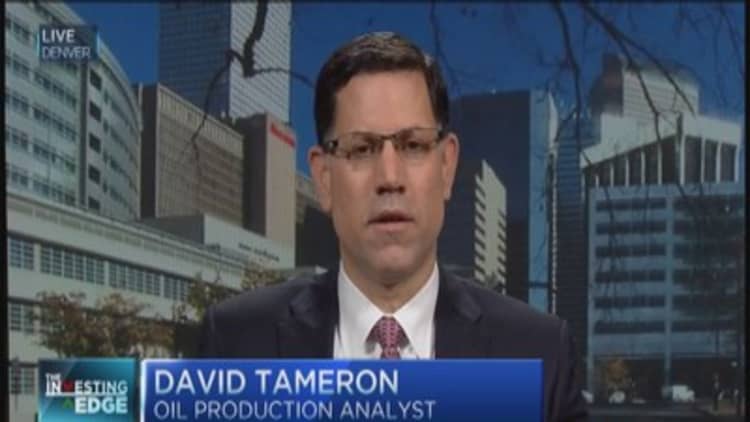
With crude prices down nearly 60 percent from their highs, investors are learning that not all oilfields are created equal.
U.S. oil production grew 49 percent between 2008 and 2013, as drillers improved productivity and tapped high-yield debt markets. But with their product fetching far less these days, exploration and production companies have slashed capital expenditure budgets and are being pickier about where they plumb for oil.
At current price levels, firms could take as many as 650 onshore rigs offline—or about one-third of the nearly 1,900 that were drilling at last year's peak in November, Wells Fargo analyst David Tameron told CNBC's "Power Lunch" recently. Last week, the U.S. rig count stood at 1,676, according to Baker Hughes.
Read MoreThe most oil and gas dependent counties in the US are…
Drillers have begun reducing rigs in big shale regions, including the Permian Basin in Texas and New Mexico, the country's highest-producing region, as well as North Dakota's Bakken Shale and the Eagle Ford in south and east Texas. But shutdowns in other, less productive and emerging areas will likely be more widespread.

The Tuscaloosa Marine Shale (TMS) has some of the nation's highest breakeven costs—about $70 to $90 a barrel for benchmark West Texas Intermediate crude—according to energy investment banking firm Tudor Pickering Holt.
The TMS lies under a swath of the Deep South that runs along the border of Louisiana and Mississippi. While it is believed to hold 7 billion barrels of oil, that black gold is buried between 11,000 feet and more than 15,000 feet below the surface. That compares with depths as shallow as 5,500 feet in some parts of the Permian Basin.
Already, exploration and production companies are pulling out. Last month, Comstock Resources suspended drilling in the TMS, and Halcon Resources said in November it would wind down operations there.
Read MoreNorth Dakota rigs at 5-year low: Dalrymple
Halcon recently slashed its drilling and completion budget roughly by half. The company has about 315,000 acres in the play and attracted $400 million in investment to drill there, according to its website.
"I'm going to do my darndest to make sure that people understand that we're highly confident and we like the play," Halcon CEO Floyd Wilson told investors on a conference call in November. "However, it is currently a relatively high-cost play, and with currently low crude prices we will not be devoting a significant portion of our resources to TMS in the near term."

Another area that will definitely see cuts is the Mississippian Lime, said Michael Rowe, an analyst at Tudor Pickering Holt. Located in Oklahoma and Kansas, the play is comprised of a basin roughly the size of West Virginia. Producers need oil at roughly $75 a barrel to break even there.
MS Lime wells produce a lot of water, and regulations connected to the water use create additional labor, transportation and power costs, said Richard Tullis, energy equity analyst at Capital One Securities.
Read More Big Oil cuts back as analysts slash forecasts
Oklahoma City-based SandRidge Energy, the largest player in the MS Lime, said this month it was reducing its rig count and capital expenditure levels. The company's shares are down nearly 80 percent over the last six months, from just under $7 to little more than $1.
The upside is that SandRidge was able to buy property in the area on the cheap, perhaps for as little as a few hundred dollars an acre, Tullis said. That compares with tens of thousands of dollars per acre in parts of the Permian when oil prices were at highs.
Low land prices make it less painful for exploration and production companies to put the brakes on projects. "I suspect you can let leases expire in the MS Lime and then come back and re-lease them for the same or better terms," Tullis said.
Producers can continue drilling in plays with break-even levels at the midrange, provided they have a top-tier capital structure, Rowe said. And they can reduce well costs not only by renegotiating prices with oilfield supply companies, but by drilling more efficiently.
Jones Energy is doing that in the Anadarko Basin, located in western Kansas and the Texas panhandle, analysts said. It produces more than 18,000 barrels of oil a day from 1,284 drilling locations across 152,000 acres in the Cleveland, Tonkawa and Marmaton areas, according to its website.
Read More It'll be ugly, but we'll survive: Canada oil pros
Those are "tight sands" plays—meaning the ground has low permeability and must be drilled using more advanced methods. They can be unpredictable from a drilling standpoint, Rowe said. Their break-even prices range from the high $50s to high $70s per barrel, but Jones thrives in the area because its focus is narrow.
"This is all they do. They know it extremely well. They build relationships with service operators in the basin and tailor well completion design depending on which zone they're trying to target," he said.
Producers who are not on the same page—on the cutting edge in terms of drilling technology and capital costs—will have to pull rigs out of pricey shale plays, Rowe said.


